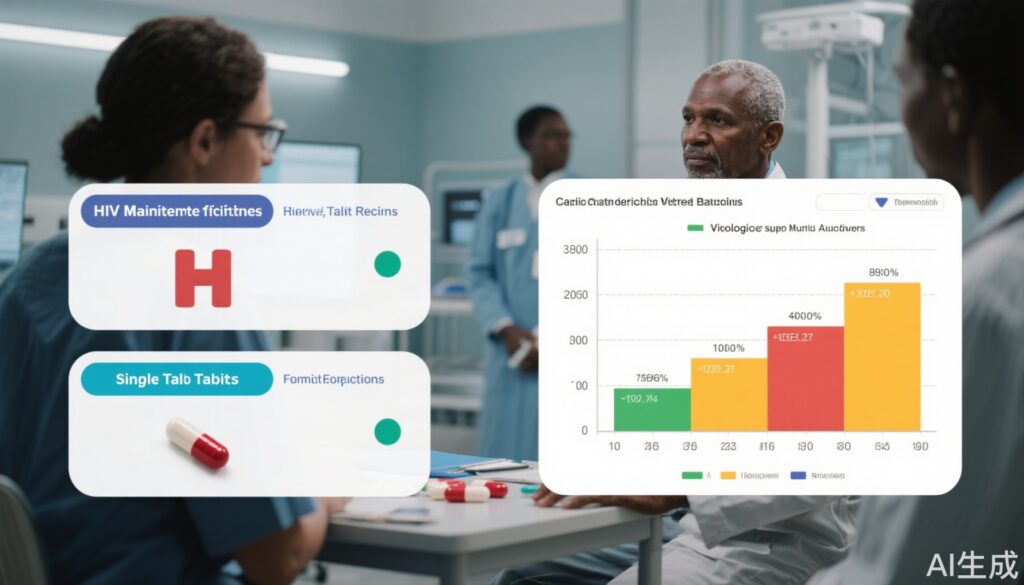Highlights
- Dolutegravir/lamivudine demonstrated non-inferiority to bictegravir/emtricitabine/tenofovir alafenamide (BIC/FTC/TAF) for virologic suppression at 48 weeks in adults with HIV-1.
- Both regimens exhibited low rates of virologic failure and similar adverse event profiles.
- Grade 3-4 adverse events were more frequent in the BIC/FTC/TAF group, though overall discontinuations due to adverse events were rare.
- The findings support regimen selection based on individual patient preferences, comorbidities, and shared decision-making.
Study Background and Disease Burden
Human immunodeficiency virus (HIV) remains a major global public health challenge, necessitating lifelong antiretroviral therapy (ART) to maintain virologic suppression, prevent disease progression, and reduce transmission. In recent years, single-tablet regimens (STRs) such as dolutegravir/lamivudine (DTG/3TC) and bictegravir/emtricitabine/tenofovir alafenamide (BIC/FTC/TAF) have become preferred options in international treatment guidelines, owing to their efficacy, tolerability, and simplicity. Despite widespread use, robust head-to-head comparative data for these regimens as maintenance therapy in virologically suppressed individuals have been lacking. Addressing this evidence gap is essential for optimizing long-term HIV management, individualizing care, and supporting informed regimen switching.
Study Design
The PASO-DOBLE trial was a randomized, multicenter, open-label, non-inferiority study conducted across 30 sites in Spain. Eligible participants were adults (≥18 years) with HIV-1 infection, virologically suppressed (HIV-1 RNA <50 copies/mL for at least 24 weeks), with no prior virological failure, and not previously exposed to dolutegravir or bictegravir. Previous ART regimens included at least one pill daily, with agents such as cobicistat, efavirenz, or tenofovir disoproxil fumarate.
Participants were randomized 1:1 to switch to either:
– DTG 50 mg + 3TC 300 mg once daily (n=277), or
– BIC 50 mg/FTC 200 mg/TAF 25 mg once daily (n=276).
Randomization was stratified by baseline TAF use and sex assigned at birth. The primary endpoint was the proportion of participants with plasma HIV-1 RNA ≥50 copies/mL at week 48 (intention-to-treat exposed population). The non-inferiority margin was set at 4%. Safety and secondary endpoints included adverse event rates, discontinuations, and laboratory abnormalities.
Key Findings
A total of 553 participants initiated study medication: 277 in the DTG/3TC arm and 276 in the BIC/FTC/TAF arm. Baseline characteristics were generally well balanced between groups.
Virologic Efficacy:
– At week 48, HIV-1 RNA ≥50 copies/mL was observed in 6 (2%) of 277 participants in the DTG/3TC group and 2 (1%) of 276 in the BIC/FTC/TAF group.
– The between-group difference was 1.4% (95% CI: -0.5 to 3.4; p=0.16), meeting the prespecified non-inferiority criterion.
– The vast majority of participants in both arms maintained virologic suppression.
Safety and Tolerability:
– The most common adverse events (AEs, ≥10% in either group) included infections, musculoskeletal, gastrointestinal, metabolic, and psychiatric events, generally mild or moderate in severity and deemed unrelated to study drugs.
– Grade 3-4 AEs were more frequent with BIC/FTC/TAF (n=10, 3%) compared to DTG/3TC (n=3, 1%; p=0.049).
– Discontinuations due to AEs were rare: 1 participant in the DTG/3TC group and 2 in the BIC/FTC/TAF group.
– There were no deaths in either group during the 48-week study period.
Clinical and Statistical Significance:
– The observed difference in virologic failure rates was not statistically significant and fell well within the non-inferiority margin.
– The low rates of discontinuation and serious AEs in both arms further support the safety and tolerability of these regimens for maintenance therapy.
Expert Commentary
The PASO-DOBLE trial provides pivotal comparative evidence for two leading single-tablet regimens in the maintenance setting. These findings are highly relevant to clinicians and patients navigating regimen choices for long-term HIV management. The similar efficacy and safety profiles observed reinforce the flexibility available in contemporary ART selection.
Despite the open-label design and geographic limitation to Spain, the multicenter nature and robust sample size enhance the generalizability of results to other high-income settings with similar ART accessibility. The slightly higher rate of grade 3-4 AEs in the BIC/FTC/TAF arm, though statistically significant, did not translate into higher discontinuation rates and should be interpreted with consideration of overall clinical context and individual patient comorbidities.
Current guideline statements from organizations such as the WHO, IAS-USA, and EACS endorse both DTG/3TC and BIC/FTC/TAF as preferred maintenance regimens, though head-to-head data such as those from PASO-DOBLE were previously lacking. This trial fills a crucial gap and may inform future guideline updates, particularly around switching strategies and shared decision-making.
Conclusion
The PASO-DOBLE trial demonstrates that dolutegravir/lamivudine is non-inferior to bictegravir/emtricitabine/tenofovir alafenamide for maintaining virologic suppression in adults with HIV-1. Both regimens are highly effective, safe, and well tolerated over 48 weeks. These findings support the use of either STR as a viable maintenance option, allowing for individualized therapy based on patient preferences, comorbidities, and cost considerations. Ongoing research should address longer-term outcomes, resistance development, and applicability in diverse populations.
References
1. Ryan P, Blanco JL, Masia M, Garcia-Fraile L, Crusells MJ, Domingo P, et al.; PASO-DOBLE study group. Maintenance therapy with dolutegravir and lamivudine versus bictegravir, emtricitabine, and tenofovir alafenamide in people with HIV (PASO-DOBLE): 48-week results from a randomised, multicentre, open-label, non-inferiority trial. Lancet HIV. 2025 Jul;12(7):e473-e484. doi: 10.1016/S2352-3018(25)00105-5.
2. Panel on Antiretroviral Guidelines for Adults and Adolescents. Guidelines for the Use of Antiretroviral Agents in Adults and Adolescents with HIV. Department of Health and Human Services. Available at: https://clinicalinfo.hiv.gov/en/guidelines
3. European AIDS Clinical Society (EACS). Guidelines Version 12.0. October 2023.


